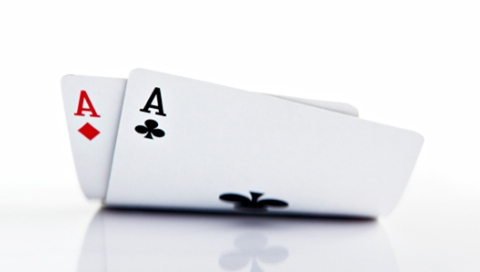Pocket Aces...The best hand in poker.
Not only did Melvin lose the pot with AA for the 5th time today but he also timed out on his other 4 tables despite holding strong hands. This was because Melvin’s expensive optical mouse finally shattered as a result of being repeatedly slammed on his desk. Not only is Melvin now in a terrible mood, but he now has to go out and spend $50 replacing his mouse before he can continue playing.
Does the above scenario sound familiar? Does it seem like your Aces just never win? Let’s consider some theory and strategy. Hopefully we can improve your success with pocket Aces!
Aces are not Invincible
This is not strategy as such, just something important you need to realise – for your emotional/mental health as much as anything. Aces mathematically have to lose a certain percentage of the time. Against any 2 random cards pocket Aces will have 85.2% equity. What does this mean in plain English?
If we were to get all-in pre-flop 100 times vs any 2 cards, Aces would lose about 15 times on average.
The hand with the most equity against pocket Aces is 56s (of a different suit to the Aces) and has ~23.1% equity. The hand with the least equity against Aces is A2o (2 is same suit as one of the Aces) which has about 6.5% equity.
Aces are only the nuts Pre-flop!
Faced with the opportunity to get all-in pre-flop we’d always take it. The decision is easy. Aces are the nuts pre-flop. There is no better hand our opponent can hold and our decision is guaranteed to be profitable in the long run.
Once the flop is dealt, that all changes. True, your Aces may still be a monster. In other cases, they may be rags, or very mediocre hands. In order to be successful you need to be able to evaluate how the strength of your Aces changes on various flop textures. Let’s consider a few.
We hold the aa on a flop of
1)a55 Your hand is stronger now than it was pre-flop in terms of equity. The only thing that beats you is 55. The rest of villains hands either have very little equity or are drawing completely dead. You may even want to consider slow-playing here. Whatever happens, you want to get all the money in.
2)k72This is a dry board. Your Aces are still very strong here. You should almost definitely go for some value from Kx. You should be very careful on dry boards though, if your opponent starts playing back. It’s true he may have a Kx but many players might choose to check-call with such a hand given the board is dry and there aren’t many hands you can have either. Seeing as your opponent cannot have any draws or such a board he may only be check-raising with sets. Usually you want to get the money in on these boards – but ideally your opponent will either be calling-down or betting himself. If he is raising or check/raising this board it should really set off some alarm signals.
3)q97 – Drawy board. Your hand is less strong here in the relative sense than on the above dry board. Ironically you should be less concerned about your opponent raising or check-raising. There are a lot of draws he can have which you are a favourite against. He may also be concerned about you having a draw and raise/check-raise a hand like AQ. If you know your opponent is capable of playing aggressively here, getting the money in often won’t be a mistake even against raises/check-raise.
4)kqj – Very drawy + coordinated board. Your hand is really not great here at all. It differs from the above board because there are more combinations of strong made hands – JJ, QQ, KK, KJ, KQ, QJ to go along with the draws. You still might hold the best hand though. You do still have a gut-shot to the nuts, and you block the Ace-high flush-draw. Ideally you want to get to showdown if you can – but if you find yourself facing a lot of aggression it’s probably better to just lay the hand down. You certainly aren’t committed here. Getting all the money in on the flop is likely a big mistake.
5)446 – Low Board. These are the most villain dependant boards. The most useful piece of information to have is; what does your opponent do with a hand like 77-JJ? Some players will automatically raise/check-raise any over-pair while others play them passively; only raising trips or better. If you know your opponent will raise/check-raise over-pairs, bluffs, and draws, you should continue with the hand. Against passive opponents you need to be more cautious; folding to a lot of aggression wouldn’t be a mistake.
6)8910 – This board is extremely co-ordinated. Your aces are little more than rags here. It might be different if you held the As, but you don’t. Even if your opponent doesn’t have you beat he is likely to have a huge amount of equity against you. Even any random spade will have over 35% equity against you. If your opponent holds the Js you are not even a favourite. There is no need to try and get to showdown on such a board. Folding to one bet is probably going to be completely acceptable.
A Common Difficult Spot
The following seems to be one of the most common way players lose their stack with AA, so watch out for it. (Check out the statistics before reviewing the hand)
MP ($25)
CO (HERO) ($25)
UTG ($25)
BB ($25)
SB ($25) (18/14/2/3) (VPIP/PFR/AF/CrFlop)
BU ($25)
Pre-flop: Hero is CO withaa
2 folds, Hero raises to $1, BU folds, SB calls $0.85, BB folds.
Flop: ($2.25) 852 2players
Hero bets $1.35, SB raises to $4.05, Hero?
It is very important to consider who you are playing against. In this example the opponent appears tight-aggressive and has a very low check-raise stat. He’s probably not check-raising a hand like 99-JJ. QQ+ he’d probably have re-raised pre-flop. Given his low check-raise stat, he’s probably not check-raise bluffing/semi-bluffing either. We should probably fold here – even though most players won’t. If the player has a fishy looking VPIP/PFR, and/or a much higher check-raise stat then it becomes ok to still get the money in.
Mental Strength
As we’ve seen – against any 2 cards Aces will lose 15 times out of a hundred. Probability is seemingly very random in the short term. You might lose with AA 25 times out of the hundred, or you might lose only 5. Sometimes your losses will be dispersed evenly throughout that 100 hands, while other times you might lose with Aces 5 times or more in a row.
Poker is not just about reading-people, making hands, and doing calculations. Sometimes it’s about how much crap you can take while still continuing to play a good solid game. Venting your frustration by destroying various computer accessories is rarely the answer. Sometimes players will lose 30 bucks and proceed to destroy a $500 laptop because they are so angry.
Even if you manage not to destroy your surroundings, even just feeling angry might cause you to make mistakes. Simply understanding that Aces have to lose a certain percentage of the time can make beats easier to deal with. If you can more accurately gauge the strength of your Aces on various flops you should also find yourself losing those big pots a lot less often too.


